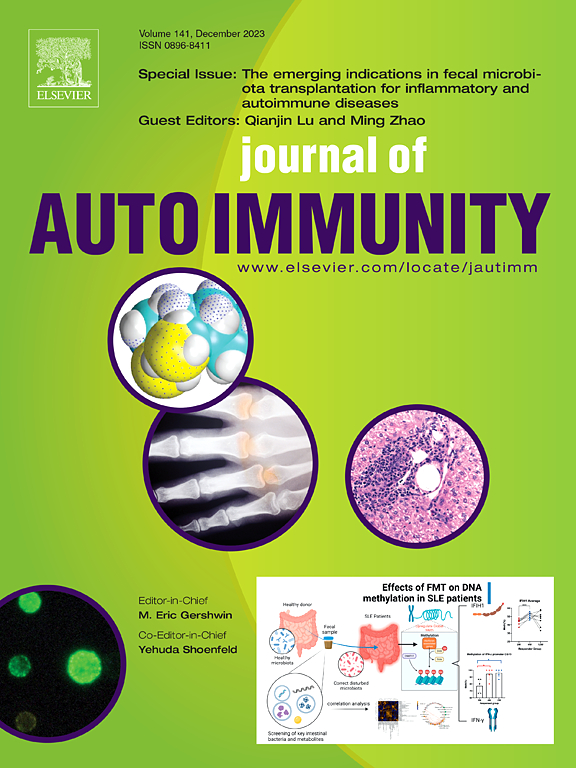Stratifying patients by TNFSF13B genotype revealed increased flare and renal flare risk, but a greater benefit from belimumab: a potential biomarker for personalized treatment in systemic lupus erythematosus
IF 7
1区 医学
Q1 IMMUNOLOGY
引用次数: 0
Abstract
Objective
To examine whether SLE patients carrying the TNFSF13B variant (BAFF-var) differ in the risk of overall and renal flares and the benefits from belimumab.
Methods
This retrospective study analyzed data from a monocentric cohort of Sardinian SLE patients between January 2006 and December 2022. We recorded demographic, clinical, serological, and treatment variables. A flare was defined as a new SLE manifestation or worsening of an existing one that required a change in therapy. Renal flares, categorized as nephritic or nephrotic, were recorded. Soluble B-cell activating factor (sBAFF) levels were evaluated in patients naïve to any treatment. We used Kaplan-Meier curves, Cox regression, and Poisson regression to investigate the association between BAFF-var and flares.
Results
Among 233 screened patients, 194 (89.2 % female, 61.3 % BAFF-var carriers) were included. The mean age was 41.1 (±14.8) years, and the mean number of follow-up visits was 17 (±8). sBAFF levels increased according to BAFF-var genotype (p < 0.001). BAFF-var was significantly associated with an increased risk of flares (HR 1.5 per copy variant; 95 %CI 1.2–2.0; p = 0.002), and the frequency of flares (IRR 1.3 per copy variant; 95 %CI 1.1–1.6; p = 0.009). In 38 biopsy-confirmed lupus nephritis patients, the BAFF-var was associated with a higher risk of renal flare (HR 9.3; 95 %CI 1.7–49.5; p = 0.008). In 35 relapsing-remitting patients, belimumab reduced both the risk and frequency of flares, with higher effectiveness in patients carrying the BAFF-var (HR 0.12; 95 %CI 0.02–0.58; p = 0.009).
Conclusions
Pending further validation, BAFF-var may serve as a predictive and prognostic biomarker for personalized treatment in SLE.

根据TNFSF13B基因型对患者进行分层显示,耀斑和肾脏耀斑风险增加,但贝利单抗的获益更大:一种潜在的系统性红斑狼疮个性化治疗的生物标志物
目的研究携带TNFSF13B变异(BAFF-var)的SLE患者在总体和肾脏发作的风险以及贝利单抗的获益方面是否存在差异。方法本回顾性研究分析了2006年1月至2022年12月撒丁岛SLE患者的单中心队列数据。我们记录了人口统计学、临床、血清学和治疗变量。耀斑被定义为新的SLE表现或现有表现的恶化,需要改变治疗。记录肾脏耀斑,分类为肾病或肾病。评估可溶性b细胞活化因子(sBAFF)水平naïve患者的任何治疗。我们使用Kaplan-Meier曲线、Cox回归和泊松回归来研究BAFF-var与耀斑之间的关系。结果在233例筛查患者中,包括194例(女性89.2%,BAFF-var携带者61.3%)。平均年龄41.1(±14.8)岁,平均随访次数17(±8)次。根据BAFF-var基因型,saff水平升高(p <;0.001)。BAFF-var与耀斑风险增加显著相关(每个拷贝变异的HR为1.5;95% ci 1.2-2.0;p = 0.002),以及耀斑发生的频率(每个拷贝变异的IRR为1.3;95% ci 1.1-1.6;p = 0.009)。在38例活检证实的狼疮性肾炎患者中,BAFF-var与肾脏耀斑的高风险相关(HR 9.3;95% ci 1.7-49.5;p = 0.008)。在35例复发缓解型患者中,贝利单抗降低了耀斑发生的风险和频率,对携带BAFF-var的患者更有效(HR 0.12;95% ci 0.02-0.58;p = 0.009)。结论BAFF-var可作为SLE个体化治疗的预测和预后生物标志物,有待进一步验证。
本文章由计算机程序翻译,如有差异,请以英文原文为准。
求助全文
约1分钟内获得全文
求助全文
来源期刊

Journal of autoimmunity
医学-免疫学
CiteScore
27.90
自引率
1.60%
发文量
117
审稿时长
17 days
期刊介绍:
The Journal of Autoimmunity serves as the primary publication for research on various facets of autoimmunity. These include topics such as the mechanism of self-recognition, regulation of autoimmune responses, experimental autoimmune diseases, diagnostic tests for autoantibodies, as well as the epidemiology, pathophysiology, and treatment of autoimmune diseases. While the journal covers a wide range of subjects, it emphasizes papers exploring the genetic, molecular biology, and cellular aspects of the field.
The Journal of Translational Autoimmunity, on the other hand, is a subsidiary journal of the Journal of Autoimmunity. It focuses specifically on translating scientific discoveries in autoimmunity into clinical applications and practical solutions. By highlighting research that bridges the gap between basic science and clinical practice, the Journal of Translational Autoimmunity aims to advance the understanding and treatment of autoimmune diseases.
 求助内容:
求助内容: 应助结果提醒方式:
应助结果提醒方式:


